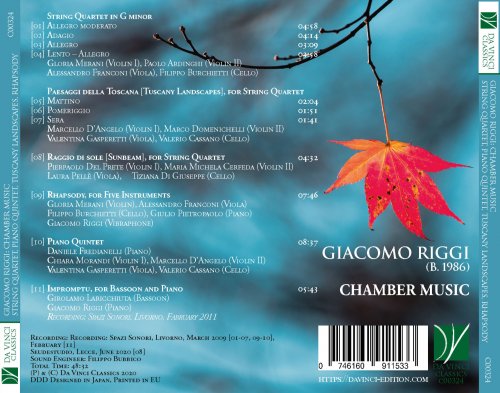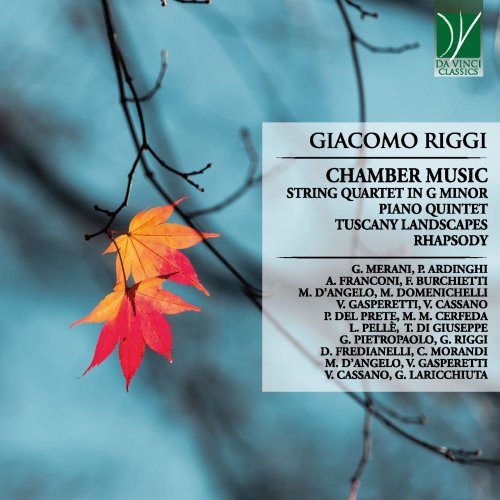
Alessandro Franconi, Chiara Morandi, Daniele Fredianelli, Filippo Burchietti, Giacomo Riggi - Giacomo Riggi: Chamber Music (2020)
BAND/ARTIST: Alessandro Franconi, Chiara Morandi, Daniele Fredianelli, Filippo Burchietti, Giacomo Riggi
- Title: Giacomo Riggi: Chamber Music
- Year Of Release: 2020
- Label: Da Vinci Classics
- Genre: Classical
- Quality: flac lossless
- Total Time: 00:48:33
- Total Size: 205 mb
- WebSite: Album Preview
Tracklist
01. String Quartet in G Minor I. Allegro moderato
02. String Quartet in G Minor II. Adagio
03. String Quartet in G Minor III. Allegro
04. String Quartet in G Minor IV. Lento - Allegro
05. Paesaggi della Toscana I. Mattino
06. Paesaggi della Toscana II. Pomeriggio
07. Paesaggi della Toscana III. Sera
08. Raggio di sole
09. Rhapsody for Five Instruments
10. Piano Quintet
11. Impromptu (For Bassoon and Piano)

Today, contemporary music enjoys a special status: a wavering fame is juxtaposed to a continuingly nuanced reception.
This starts from its very definition, since justifying for human beings what is contemporary (i.e. “of the present day”, “of the now”, “of the hic et nunc”) is an instinctive tendency both for our species and for many others in the animal realm.
When contemporary music is concerned, however, the matter gets complicated in comparison, for example, to a painting which clearly cannot enjoy an aural mobility.
The simple justification of something as being “an output of the present day” loses its meaning almost entirely.
Music itself, in fact, became shattered in innumerable spaces, avantgardes, fortresses and free rivers, and each of them has an identity of its own (or is in quest for it, as happens since the times of Alfredo Casella).
It is also extremely complex, for composers, to define and create a poetics of their own, supporting them and making them recognizable in the aural mare magnum accompanying our existence; moreover, it is complex for this output to reach the highest possible number of people who are (or may be) the ultimate receivers of their work.
This led, from the one side, to an extreme attempt to disconnect oneself from the past, with the risk of sterility and utopia; from the other, to the plundering of styles and “modes” attributable to a past whose range varies depending on the composer.
With increasing frequency, one glimpses a mixture of these two tendencies.
In its novelty, it is nothing else than the recovery of a balance which partly got broken in the first years of the twentieth century. It gives back to the artistic and musical dimension the crossroads of “past/evolution”.
It gets pacified with respect to its phantasms, which are frequently felt as too cumbersome, especially when they are historicized.
Giacomo Riggi can doubtlessly define himself as part of this latter current: in the attempt to propose a thought of its own, this current wisely balances modules (not modes) coming from the European (and not only European) musical past.
One has only to think of harmonies, which are occasionally reminiscent of Dvořák’s Slavic symphonic tradition, as in Paesaggio della Toscana (composed for a competition of music for images), and in particular Il Mattino.
Or else, there is the use of cutting harmonies leading us close to the atmospheres of Bernard Hermann, as happens with the Quartetto in G minor.
This was the composer’s first experience in this genre, and here every idea flows in a free and spontaneous fashion.
This happens to an even higher degree in the Rapsodia per cinque strumenti, where jazz influences are also found, along with a homage to the figure of Chick Corea.
Thence the leap is made to music applied to images – i.e. to cinema: Riggi does not explicitly touch this medium in most of his pieces, but frequently seems to brush against it, through a narrative which powerfully suggests an action or a gesture rather than closing itself in its asemanticity.
In Sunbeam he explicitly refers to a Spanish anonymous short movie of 1912 recounting the journey of a man heading towards the Palace of Queen Sunbeam.
One could also cite the model of Brahms’ chamber music writing, overwhelmingly appearing in the Piano Quintet, which continuously veers, particularly in the Finale, towards an exquisite ideal with a clearly symphonic style.
No element in these works, however, concurs to creating a homage, a divertissement or a variation upon a theme.
Quite the contrary: it is precisely by appropriating and interiorizing a multitude of elements that Riggi traces a path of his own, which is extremely recognizable; he later adds it up to the experiences of many other media and of non-“cultivated” styles of the twentieth-century tradition.
Leading these back to a poetics of his own, the composer expresses the potential of his palette of sound at its best in these chamber music works, chiseling a complex fresco made of the continuous intertwining of suggestions, in the constant tension of a gaze facing the future of his art, in awareness of and respect for what preceded him.
01. String Quartet in G Minor I. Allegro moderato
02. String Quartet in G Minor II. Adagio
03. String Quartet in G Minor III. Allegro
04. String Quartet in G Minor IV. Lento - Allegro
05. Paesaggi della Toscana I. Mattino
06. Paesaggi della Toscana II. Pomeriggio
07. Paesaggi della Toscana III. Sera
08. Raggio di sole
09. Rhapsody for Five Instruments
10. Piano Quintet
11. Impromptu (For Bassoon and Piano)

Today, contemporary music enjoys a special status: a wavering fame is juxtaposed to a continuingly nuanced reception.
This starts from its very definition, since justifying for human beings what is contemporary (i.e. “of the present day”, “of the now”, “of the hic et nunc”) is an instinctive tendency both for our species and for many others in the animal realm.
When contemporary music is concerned, however, the matter gets complicated in comparison, for example, to a painting which clearly cannot enjoy an aural mobility.
The simple justification of something as being “an output of the present day” loses its meaning almost entirely.
Music itself, in fact, became shattered in innumerable spaces, avantgardes, fortresses and free rivers, and each of them has an identity of its own (or is in quest for it, as happens since the times of Alfredo Casella).
It is also extremely complex, for composers, to define and create a poetics of their own, supporting them and making them recognizable in the aural mare magnum accompanying our existence; moreover, it is complex for this output to reach the highest possible number of people who are (or may be) the ultimate receivers of their work.
This led, from the one side, to an extreme attempt to disconnect oneself from the past, with the risk of sterility and utopia; from the other, to the plundering of styles and “modes” attributable to a past whose range varies depending on the composer.
With increasing frequency, one glimpses a mixture of these two tendencies.
In its novelty, it is nothing else than the recovery of a balance which partly got broken in the first years of the twentieth century. It gives back to the artistic and musical dimension the crossroads of “past/evolution”.
It gets pacified with respect to its phantasms, which are frequently felt as too cumbersome, especially when they are historicized.
Giacomo Riggi can doubtlessly define himself as part of this latter current: in the attempt to propose a thought of its own, this current wisely balances modules (not modes) coming from the European (and not only European) musical past.
One has only to think of harmonies, which are occasionally reminiscent of Dvořák’s Slavic symphonic tradition, as in Paesaggio della Toscana (composed for a competition of music for images), and in particular Il Mattino.
Or else, there is the use of cutting harmonies leading us close to the atmospheres of Bernard Hermann, as happens with the Quartetto in G minor.
This was the composer’s first experience in this genre, and here every idea flows in a free and spontaneous fashion.
This happens to an even higher degree in the Rapsodia per cinque strumenti, where jazz influences are also found, along with a homage to the figure of Chick Corea.
Thence the leap is made to music applied to images – i.e. to cinema: Riggi does not explicitly touch this medium in most of his pieces, but frequently seems to brush against it, through a narrative which powerfully suggests an action or a gesture rather than closing itself in its asemanticity.
In Sunbeam he explicitly refers to a Spanish anonymous short movie of 1912 recounting the journey of a man heading towards the Palace of Queen Sunbeam.
One could also cite the model of Brahms’ chamber music writing, overwhelmingly appearing in the Piano Quintet, which continuously veers, particularly in the Finale, towards an exquisite ideal with a clearly symphonic style.
No element in these works, however, concurs to creating a homage, a divertissement or a variation upon a theme.
Quite the contrary: it is precisely by appropriating and interiorizing a multitude of elements that Riggi traces a path of his own, which is extremely recognizable; he later adds it up to the experiences of many other media and of non-“cultivated” styles of the twentieth-century tradition.
Leading these back to a poetics of his own, the composer expresses the potential of his palette of sound at its best in these chamber music works, chiseling a complex fresco made of the continuous intertwining of suggestions, in the constant tension of a gaze facing the future of his art, in awareness of and respect for what preceded him.
Year 2020 | Classical | FLAC / APE
As a ISRA.CLOUD's PREMIUM member you will have the following benefits:
- Unlimited high speed downloads
- Download directly without waiting time
- Unlimited parallel downloads
- Support for download accelerators
- No advertising
- Resume broken downloads


